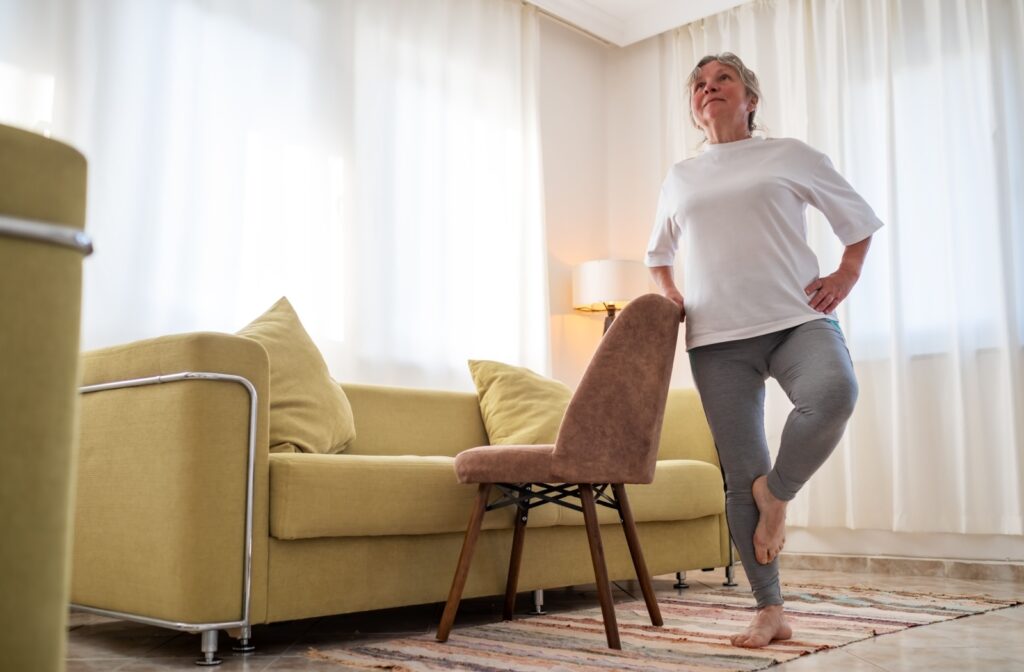Participating freely in everything a community has to offer is one of the things that makes senior living so enjoyable. And this is possible for seniors who maintain their balance and strength through exercise. Improved physical and mental health, a general sense of independence, and a higher quality of life are a few reasons why seniors should perform balance exercises.
It’s important to remember that there are no black-and-white answers for which exercises an individual should do. This is especially true for seniors who may have certain mobility issues that require exercise modification. An older adult should always consult with their healthcare provider before beginning any new exercise routine.
How Does Age Affect Balance?
Weakening muscles, slowing reflexes, and vision problems can all contribute to changes in our balance and coordination. As we age, everyday activities can become increasingly difficult and the risk of tripping or falling can go up.
It’s important to consider how this risk of falling can affect your or your loved one, because 1 in 4 Americans aged 65 and older falls, making falls a leading cause of injury among seniors. These falls often lead to severe injuries, and they can even be life threatening in many instances. This is why improving balance through exercises is vital.
The Role of Flexibility & Strength Training in Balance
Stretching exercises keep your muscles limber, while strength training builds muscle mass and increases strength—both of which support a person’s body. Seniors should try to incorporate balance-specific exercises into their weekly routine to create a holistic approach to their health and wellness.
Reasons a Senior Should Perform Balance Exercises
Improved balance through exercise can benefit a senior in several ways.
Improved Strength, Stability, and Mobility
Increased muscle strength, especially in the lower body and core, is a significant benefit of balance exercise. The resulting improved muscular strength can lead to improved stability and mobility, which can reduce the risk of falls. And the enhanced overall physical fitness from balance exercises also contributes to a senior’s heart health and energy levels.
Enhanced Cognitive Function
The benefits of balance exercises don’t stop with the strength, mobility, and stability improvements. Many senior’s notice a boost in their mental well-being. Regular exercise has been shown to improve memory and cognitive function, helping to keep the mind sharp as one ages.
Independence & Quality of Life Improvement
Another significant benefit of balance exercises is their potential for enhancing quality of life. When you can move confidently without fear of falling, your independence soars. This can create a domino effect that encourages social engagement, pursuing new hobbies, and generally creating a more enjoyable and fulfilling retirement.
Daily Balance Exercises with an Emphasis on Safety
Integrating balance exercises into your daily life should be the ultimate goal. Consistency is vital, so find exercise activities you enjoy and make them a regular part of your day, rather than forcing yourself to do an exercise you don’t like because “you’re supposed to.”
Everyone’s focus during exercise should be the correct form for injury prevention. A couple of things for seniors to consider when exercising include:
- Ensure you have a clear environment free of tripping hazards
- Consider using support until you’re comfortable without it
- Listen to your body and don’t go beyond your comfort zone
Easy Balance & Stability Exercises for a Senior
The following are a few exercises that a senior can incorporate into their routine to improve balance and stability.
Single-Leg Stand
Stand behind a sturdy chair and hold onto the back for support. Lift one leg off the ground and hold the position for 10-15 seconds. Switch legs and repeat. This exercise helps improve balance and leg strength.
Heel-to-Toe Walk
Find a clear path and walk in a straight line, placing the heel of one foot directly in front of the toes of the other foot with each step. Focus on a point straight ahead to maintain balance. This exercise enhances coordination and stability.
Chair Sit-to-Stand
Sit on a sturdy chair with your feet flat on the floor. Slowly stand up without using your hands, then carefully sit back down. Repeat 10-15 times. This exercise strengthens the legs and improves balance during daily activities.
Toe Lifts
Stand with feet hip-width apart and rise onto your toes, holding the position for a few seconds before lowering yourself back down. Repeat 10-15 times. This exercise enhances balance by strengthening the calves and ankles.
Side Leg Raises
Stand behind a chair and hold onto the back for balance. Slowly lift one leg to the side without bending the knee, then lower it back down. Repeat 10-15 times on each leg. This exercise helps improve balance and hip stability.
Tandem Stance
Stand with one foot directly in front of the other, heel touching the toes. Hold this position for 20-30 seconds, then switch which foot is in the front. This exercise strengthens the core and improves balance and coordination. Ensure you have nearby support if needed.
Get the Support You Need
Good balance is an essential component of a happy, independent life. By consistently incorporating balance exercises into their daily life, a senior can reduce their risk of falling and enhance the quality of their golden years
Your journey to a strong, independent lifestyle starts with a single step in the right direction. Call our team at Boulder Ponds Senior Living today for personalized advice on beginning your balance exercise journey. We’re happy to schedule a community tour with you and your loved one so you can see the support available in our community.



